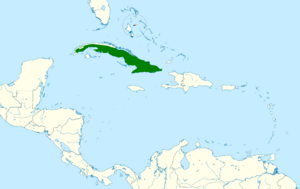Cuban grassquit facts for kids
Quick facts for kids Cuban grassquit |
|
|---|---|
 |
|
| Male at Canberra Walk In Aviary, Australia | |
| Conservation status | |
| Scientific classification | |
| Genus: |
Phonipara
|
| Species: |
canora
|
 |
|
| Synonyms | |
|
Loxia canora (protonym) |
|
The Cuban grassquit (scientific name: Phonipara canora) is a small, colorful bird. It belongs to the tanager family, called Thraupidae. This special bird lives only in Cuba, which means it is endemic to that island.
You can find it in different places like warm, wet lowland forests, mountain forests, or dry, bushy areas. It can even live in places where forests used to be.
Contents
Meet the Cuban Grassquit
The Cuban grassquit is a tiny bird, known for its bright colors. Males often have striking patterns that make them stand out. They are part of a large group of birds called tanagers.
These birds are an important part of Cuba's wildlife. They help keep the ecosystem healthy.
Where Does It Live?
The Cuban grassquit is a true native of Cuba. This means it naturally lives there and nowhere else in the world. It makes its home in several types of places.
It likes warm, wet forests found in low areas. It also lives in moist forests high up in the mountains. Sometimes, you can find it in dry, bushy lands. Even areas where forests were cut down can be home to these adaptable birds.
Naming the Cuban Grassquit
The Cuban grassquit got its official scientific name a long time ago. A German scientist named Johann Friedrich Gmelin first described it in 1789. He called it Loxia canora back then.
He based his description on drawings and notes from another naturalist, Peter Brown. Brown had drawn a bird that belonged to Marmaduke Tunstall. At first, they thought the bird came from Mexico, but it was later found to be from Cuba.
How Its Name Changed
For a while, this bird was placed in a group called Tiaris. But scientists later used new tools, like studying bird DNA. In 2014, a study showed that the Tiaris group was not quite right.
Because of this, the Cuban grassquit was moved to a different group. This new group was named Phonipara by a French naturalist, Charles Lucien Bonaparte, way back in 1850. The name Phonipara comes from old Greek and Latin words. Phōnēs means "vocal," and parus means "tit." This hints at the bird's singing ability.
The second part of its name, canora, comes from the Latin word canorus. This means "melodious" or "tuneful." So, its name basically means "vocal melodious tit-like bird."
One of a Kind
The Cuban grassquit is considered "monotypic." This means there are no different types or "subspecies" of this bird. All Cuban grassquits are very similar, no matter where they live in Cuba.
Its Bird Family Tree
For many years, scientists thought the Cuban grassquit belonged to the same family as buntings and New World sparrows. This family was called Emberizidae.
However, modern genetic studies changed this view. These studies showed that the Cuban grassquit is actually part of the tanager family, Thraupidae. It belongs to a smaller group within tanagers called Coerebinae. This shows how science helps us learn more about the natural world.
See also
 In Spanish: Tomeguín del pinar para niños
In Spanish: Tomeguín del pinar para niños


